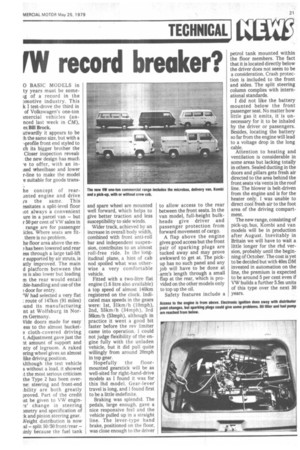fiN record breaker?
Page 23

If you've noticed an error in this article please click here to report it so we can fix it.
0 BASIC MODELS in ty years must be someig of a record in the Dmotive industry. This k I test-drove the third in of Volkswagen's one-ton imercial vehicles (anneed last week in CM), ea Bill Brock.
utwardly it appears to be 1 the same size, but with a .-profile front end styled to ch its bigger brother the Closer inspection reveah the new design has much -e to offer, with an inised wheelbase and lower r-line to make the model e suitable for goods trans:.
he concept of rearanted engine and drive the same. This essitates a split-level floor iot always a convenient ure in a parcel van — but r 50 per cent of VW sales in range are for passenger ides. Where seats are fit, there is no problem.
he floor area above the en! has been lowered and rear ess through a large tail-lift ir supported by air struts, is atly improved. The main d platform between the es is also lower but loading m the rear would entail ible-handling and use of the door for entry.
rW had selected a very flat : route of 147km (91 miles) ■ und its manufacturing nt at Wolfsburg in Norm Germany.
Vide doors made for easy :ess to the almost bucket e cloth-covered driving t. Adjustment gave just the it amount of support and nty of legroom. A raked ering wheel gives an almost like driving position.
klthough the test vehicle s without a load, it showed it the most serious criticism the Type 2 has been overne: steering and front-end ibility are both greatly proved. Part of the credit ist be given to VW enginCs' change in steering mnetry and specification of :k and pinion steering gear. Weight distribution is now el — split 50/50 front/rear — iinly because the fuel tank and spare wheel are mounted well forward, which helps to give better traction and less susceptibility to side winds.
Wider track, achieved by an increase in overall body width, combined with front anti-roll bar and independent suspension, contributes to an almost roll-free ride. In the longitudinal plane, a hint of cab nod spoiled what was otherwise a very comfortable vehicle.
Fitted with a two-litre flat engine (1.6 litre also available) a top speed of almost 140km registered on the clock. Indicated max speeds in the gears were: 1st, 31km/h (10mph), 2nd, 55km/h (34mph), 3rd 56km/h (53mph), although in practice it went a good bit faster before the rev limiter came into operation. I could not judge flexibility of the engine fully with the unladen vehicle, but it did pull quite willingly from around 20mph in top gear.
Hopefully the floormounted gearstick will be as well-sited for right-hand-drive models as I found it was for this lhd model. Gear-lever travel is long, and I found first to be a little indefinite.
Braking was splendid. The pedals, large enough, gave a nice responsive feel and the vehicle pulled up in a straight line. The lever-type hand brake, positioned on the floor, was close enough to the driver to allow access to the rear between the front seats. In the van model, full-height bulkheads give driver and passenger protection from forward movement of cargo.
A flap above the engine gives good access but the front pair of sparking plugs are tucked away and may prove awkward to get at. The pickup has no such panel and any job will have to be done at arm's length through a small flap at the rear, which is provided on the other models only to top up the oil.
Safety features include a petrol tank mounted within the floor members. The fact that it is located directly below the driver does not seem to be a consideration. Crash protection is included to the front and sides. The split steering column complies with international standards.
I did not like the battery mounted below the front passenger seat. No matter how little gas it emits, it' is unnecessary for it to be inhaled by the driver or passengers. Besides, locating the battery so far from the engine will lead to a voltage drop in the long cable.
Attention to heating and ventilation is considerable in some areas but lacking totally in others. Sealed ducting in the doors and pillars gets fresh air directed to the area behind the front seats via vents in the roof line. The blower is belt-driven from the engine and is for the heater only. I was unable to direct cool fresh air to the foot area of the driving compartment.
The new range, consisting of pick-up, bus, Kombi and van models will be in production after August. Inevitably in Britain we will have to wait a little longer for the rhd version, probably until the beginning of October. The cost is yet to be decided but with 40m DM invested in automation on the line, the premium is expected to be around 5 per cent even if VW builds a further 5.5m units of this type over the next 30 years.




























































































































